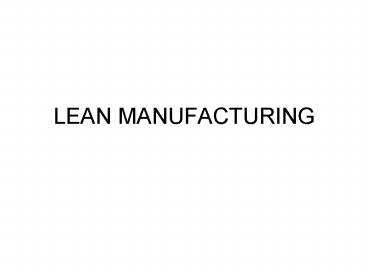LEAN MANUFACTURING - PowerPoint PPT Presentation
1 / 19
Title: LEAN MANUFACTURING
1
LEAN MANUFACTURING
2
Introduction
- Modern business model impact on business
- Business growth New technologies
- - Cross border
markets - Increasing business cost Lean manufacturing
3
Definition
- No conclusive definition
- Principles
- Efficiency Increased value of organization
- Identify and eliminate wasteful processes
- Increased innovation and development
4
Research objectives and Approach
- Objective Examine and explore how lean
manufacturing instruments can be tailored from
discreet to continuous manufacturing setting and
assess their impact on business interest - Hypothesis There are immense prospects and
opportunities for greater efficiency,
improvement, and performance of manufacturing
companys production process in lean
manufacturing instruments are used - Approach Methodically establish importance of
lean manufacturing tool in production
5
Background and scope
- Originated from Japan Scarcity of raw materials
and human labor - Taiichi Ohno Eiji Toyoda Toyota Motor Group
Executives - Toyota Production System - LM
- Principle Reduce waster, produce what customer
wants at right time and quantity
6
Mass Production to Lean Production
- Mass production utilize economies of scale
- Lean Production Functional efficiency and
effectiveness of production system - Areas of enquiry
- Staff skills
- Company resources
- Company system and procedures
- Audit role, relationships and responsibilities
7
Value Chain Analysis
- Closely linked to value chain analysis (VCA)
- VCA as a Prerequisite for LM identify functions
not structures of a company - Identify processes that add value to customers.
- VCA enable manager to identify
- Activities close to organizational objectives
- Cost-intensive activities
- Activities that create value to customers
8
Lean Tools and Techniques
- Main instruments include
- Continuous improvement
- Cellular manufacturing
- Waste recognition and elimination
- Production smoothing
- Standardization
- Just-In-Time (JIT) production
9
Continuous improvement
- In Japan Kaizen or quest for perfection and
excellence - 5Ss
- Sort
- Straighten
- Sweep Clean
- Systemize
- Standardize
10
Cellular manufacturing
- The greatest foundation of LM
- Cell production tools and stations
- Enable one-piece flow model
- Product mix extension
- Space utilization
- Reduce transport and communication
- Teamwork and communication
- Visibility and flexibility
- Improved productivity
- Lead time reduction
11
Waste recognition and elimination
- Key identifying customer preferences
- Seven subheadings
- Excess production
- Producing faulty or substandard merchandise
- Idle inventories
- Transportation
- Invisible processing
- Waiting
12
Production Smoothing
- Derived from Japanese Heijunka - keeping levels
of production consistent each day - TPS cost minimized by manufacturing parts that
could be sold - Production plan and timetable must be smooth
13
Standardization
- Work standardization corollary of waste
elimination - Ensure each duty is performed
- Standardization for a specific job, regardless
of who is performing it, produce same results.
14
Just-In-Time Production
- Administrative concept seeks to abolish wastes
- Rely on relationship between sales and purchasing
department - Three aspects
- JIT production
- JIT distribution
- JIT purchasing
- All elements integrated and synchronized
15
Opportunities for lean
- Not all LM instrument can be applied
homogeneously - LM is beneficial to manufacturing companies
- Flexibility Indicates the LM tool to be employed
16
Conclusion
- Objective elaborate the broad philosophy of
lean manufacturing and its relevance to
production process - Discrete industries share common attributes
facilitating implementation of LM tools - Identification and elimination of wastes
- Implementation of LM hampered by some barriers
- Confirmation of the hypothesis
17
Future direction
- Emerging trends in production higher prospects
of LM - Conversion of production system to purely pull
system - Future design - assimilate push and pull system
18
Bibliography of authors
- Prof. Fawaz Abdullah
- Jeffery K. Liker and Thomas Lamb
- Prof. Lerman Crookes
- Cook Robert
19
END































